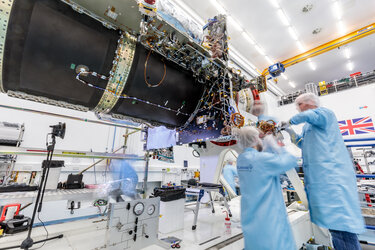Reprogrammable satellite completes radio-frequency tests
A European satellite capable of being completely repurposed after launch — developed within an ESA Partnership Project — has concluded its radio-frequency tests at a specialised facility in Toulouse.
Eutelsat Quantum is a sophisticated software-defined satellite, preparing the way for the next generation of telecommunication satellites that can be reprogrammed in orbit. It offers unprecedented in-orbit reconfigurability in coverage, frequency and power, which allows for complete mission rehauls including changes in orbital position.
Engineers involved in the ESA Partnership Project from manufacturer Airbus, operator Eutelsat and ESA have developed new working practices that have enabled them to keep working during the coronavirus pandemic. This ensures that the satellite will be fully ready to launch next year.

The radio-frequency tests are the last time that the satellite's payload will be switched on until after its launch.
Shawn Locke, ESA payload engineer for Eutelsat Quantum, said: “Due to the inherent flexible nature of the satellite, the approach to validation was far from conventional, requiring a complex range of frequencies and configurations. We have been working closely in partnership with Eutelsat, Airbus and Surrey Satellite Technology Ltd to ensure optimal spacecraft performance in orbit. This partnership has leveraged a valuable range of technical expertise from the different stakeholders, facilitating a successful design, build and test of this unique mission.”

Silvia Fedi, another ESA payload engineer for Eutelsat Quantum, said: “The payload comprises a receiver section manufactured by Airbus in Spain and a processing and transmitting element developed by Airbus in the UK, employing hardware from all over Europe. It is a highly innovative architecture, providing unprecedented flexibility during operation. The teams have been working on this since 2015 and it is rewarding to see the culmination of these efforts as the satellite finishes the final validation.”
The development of the satellite under an ESA Partnership Project has been an enabler for European industry, paving the way for the new generation of standardised telecommunications satellites, which will be more flexible and so more adaptable to customer needs once in orbit.
ESA Partnership Projects allow European industry to maintain and continue developing their competitiveness on the worldwide commercial market and enable greater risk sharing, where ESA bears the risks related to the development of innovative solutions and the partner assumes the commercial risks to respond to market needs.















 Germany
Germany
 Austria
Austria
 Belgium
Belgium
 Denmark
Denmark
 Spain
Spain
 Estonia
Estonia
 Finland
Finland
 France
France
 Greece
Greece
 Hungary
Hungary
 Ireland
Ireland
 Italy
Italy
 Luxembourg
Luxembourg
 Norway
Norway
 The Netherlands
The Netherlands
 Poland
Poland
 Portugal
Portugal
 Czechia
Czechia
 Romania
Romania
 United Kingdom
United Kingdom
 Slovenia
Slovenia
 Sweden
Sweden
 Switzerland
Switzerland






























